Bowls
English antique silver bowls can be found dating back to the early 1600’s. These shallow porringers, with a single pierced side handle, were made between 1625 and 1730 and are sometimes referred to as bleeding bowls. These fine collector’s items can be seen in major museum collections however they are still practical and able to be used for serving snacks and titbits such as nuts and small biscuits.
When Tea was introduced into England during the 17th century the first small bowls appeared which were Tea Bowls, circa 1680, followed by small antique silver Sugar Bowls in c.1710, the early examples often with covers. The octagonal shape is particularly prized.
Antique silver punch bowls were introduced in the late 1600’s. Food at this time was heavily spiced and a cooling drink was needed such as wine or the newly fashionable punch. Hence the requirement for a large bowl which could be filled with either a drink or ice. Some were fitted with a shaped removable rim which could be used to hold stem glasses, punch ladle and lemon squeezer and a bowl of this type is referred to as a Monteith. These large bowls are used nowadays for a variety of purposes such as fruit bowls, rose bowls, wine coolers or a beautiful flower display.
From the late 18th century onwards many different types of bowl were introduced, for a variety of purposes, in plain or decorative designs, and in a vast array of shapes and sizes.
Bowls make a fascinating collector’s theme, particularly those made by special makers such as Paul Storr, Elkington and the contemporary silversmith Gerald Benney. Bowls are not only practical but also very decorative and frequently used by interior designers to complement room settings. Of course the best place for a bowl is on the dining table where it can be used as a centrepiece, for serving food or wine, or simply for table decoration.
Bowls
English antique silver bowls can be found dating back to the early 1600’s. These shallow porringers, with a single pierced side handle, were made between 1625 and 1730 and are sometimes referred to as bleeding bowls. These fine collector’s items can be seen in major museum collections however they are still practical and able to be used for serving snacks and titbits such as nuts and small biscuits.
When Tea was introduced into England during the 17th century the first small bowls appeared which were Tea Bowls, circa 1680, followed by small antique silver Sugar Bowls in c.1710, the early examples often with covers. The octagonal shape is particularly prized.
Antique silver punch bowls were introduced in the late 1600’s. Food at this time was heavily spiced and a cooling drink was needed such as wine or the newly fashionable punch. Hence the requirement for a large bowl which could be filled with either a drink or ice. Some were fitted with a shaped removable rim which could be used to hold stem glasses, punch ladle and lemon squeezer and a bowl of this type is referred to as a Monteith. These large bowls are used nowadays for a variety of purposes such as fruit bowls, rose bowls, wine coolers or a beautiful flower display.
From the late 18th century onwards many different types of bowl were introduced, for a variety of purposes, in plain or decorative designs, and in a vast array of shapes and sizes.
Bowls make a fascinating collector’s theme, particularly those made by special makers such as Paul Storr, Elkington and the contemporary silversmith Gerald Benney. Bowls are not only practical but also very decorative and frequently used by interior designers to complement room settings. Of course the best place for a bowl is on the dining table where it can be used as a centrepiece, for serving food or wine, or simply for table decoration.
-

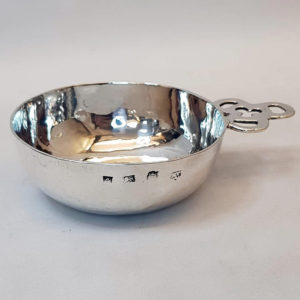
1625
Robert Profit
9989 Charles I Antique Silver Bowl
Sold
An extremely early date. A rare antique silver porringer (or bleeding bowl) of plain circular form. The straight sided shape with a simple rim is the earliest type and in keeping with the early date. Small proportions and very charming with the original hand beaten finish. A useful serving bowl, handy for nuts and sweets. Prick marked on the edge of the rim with the initials “MC”. Weight 108 grams, 3.4 troy ounces. Diameter 10.3cm. Height 3.5 cm. Spread 14cm. London 1625. Maker “RP” possibly Robert Profit (David Mitchell’s “Silversmiths in Elizabethan and Stuart London”).
-

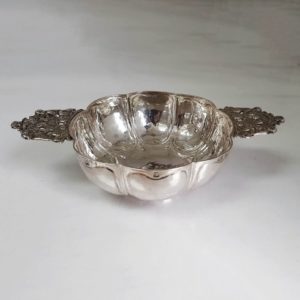
Circa 1685
9779 Antique Dutch Silver Brandy Bowl
£1,650
An antique Dutch silver bowl with lobed decoration and cast pierced handles showing three children climbing on a grape vine. Good large size. Weight 213 grams, 6.8 troy ounces. Height 6cm. Spread 24.21cm. Diameter 14.3cm. Dutch silver marks for Haarlem 1740.
-

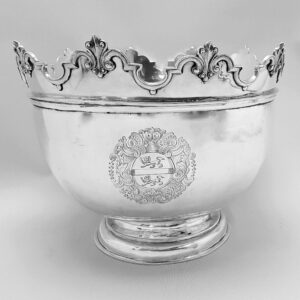
1708 - 1709
William Charnelhouse
10379 Queen Anne Antique Silver Monteith
£12,750
A spectacular sized antique silver bowl with the original castellated collar mounted with shaped strapwork and fleur de lys motifs. Very handsome design and excellent proportions. The bowl design is typical for a monteith of the period 1700-1720 with its plain form on a built-up foot and the large hand engraved coat of arms. Weight 2597g, 83 troy oz. Height 26.5cm (with Monteith collar), 20cm (bowl). Diameter 35cm (collar), 32cm (bowl). London 1708/09. Maker William Charnelhouse. Britannia standard silver – 95.8% pure. 18th century.
-

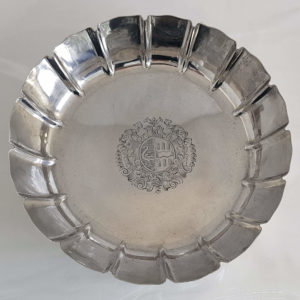
1709
Nathaniel Lock
10208 Queen Anne Antique Silver Dish
£5,500
An early English antique silver bowl with scalloped edge and unusually deep bowl with 16 segments. This form is usually called a strawberry dish or salad dish. Hand engraved to the centre is a family armorial, incorporating a swan, within a decorative cartouche. Britannia standard silver. Superb colour. Weight 519 grams, 16.6 troy ounces. Height 5cm. Diameter 23.3cm. London 1709. Maker Nathaniel Lock.
-

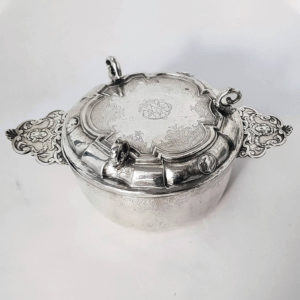
1724 - 1728
Johann Christoph Treffler
9884 Early 18th Century German Silver Ecuelle and Cover
£6,750
A rare and highly desirable antique silver bowl with matching lid, the cast side handles with face masks and foliate scroll work. Handy size, suitable for serving vegetables. The cover, applied with portrait medallions and three scroll and dolphin feet, can be inverted for use as a bowl stand or a spoon tray. The rim of the bowl and cover are hand engraved with decorative strapwork designs. The centre top has a large monogram with intertwined initials in old fashioned script, repeated to the outside of the bowl (worn). Weight 391 grams, 12.5 troy oz. Height 6cm (bowl), 9.5cm (bowl and lid). Diameter 13.4cm. Spread 22cm. German silver marks for Augsburg. Maker Johann Christoph Treffler 1724-28.
-

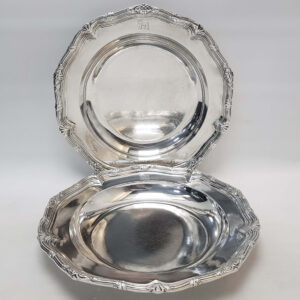
1734
Paul de Lamerie
10326 George II Antique Silver Dishes by Paul de Lamerie
£14,750
An important pair of antique silver second course dishes by the celebrated Huguenot maker Paul de Lamerie. The plates have a generous, dished bowl with a shaped, reed and shell border. There is a hand engraved crest to the edge of the rim. Total weight 1988 grams, 63.9 troy oz. Diameter 28.5cm. Height 3.8cm. London 1734. Maker Paul de Lamerie. Sterling silver. 18th century.
-

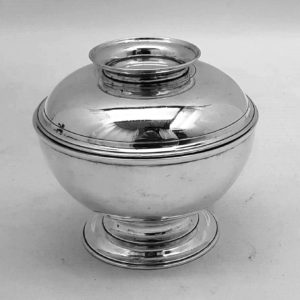
1748
Samuel Taylor
9867 George II Covered Sugar Bowl
Sold
A rare antique sterling silver covered sugar bowl of circular form on a small spreading foot. Excellent plain design, typical of the period. Good colour. In the early 18th century sugar bowls or sugar boxes nearly always had covers which, when reversed, could be used as a saucer or spoon tray. Weight 219 grams, 7.0 troy ounces. Total height 9cm. Bowl diameter 9.7cm. London 1748. Maker probably Samuel Taylor a specialist tea caddy and sugar bowl maker.
-

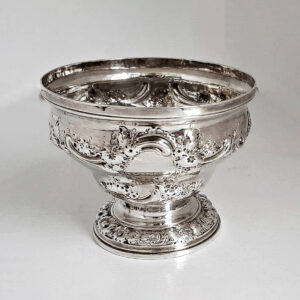
1754
Samuel Taylor
9723 George II Silver Sugar Bowl
£675
An antique silver bowl with extensive embossed decoration of flowers, leaves and scrolls. To the front is a rococo design cartouche – uninscribed. Superb quality and heavy gauge silver. No lid. Weight 222g, 7.1 troy oz. Height 8.4cm. Diameter 10.5cm
. London 1754. Maker Samuel Taylor. Sterling silver. -

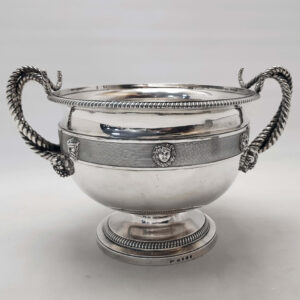
1805
William Fountain
10353 George III Antique Silver Bowl
Reserved
An antique silver bowl of plain circular form on a stepped foot with broad gadrooned borders. The decoration is very striking with the single band of matted ornament with applied bacchanalian face masks and magnificent twin coiling rope handles each culminating in basket of fruit. Good size and substantial weight. Weight 3784g, 121.6 troy oz. Height 22.4cm (to top of handle). Spread across handles 35cm. Diameter 25cm. London 1805. Maker William Fountain. Sterling silver.
-

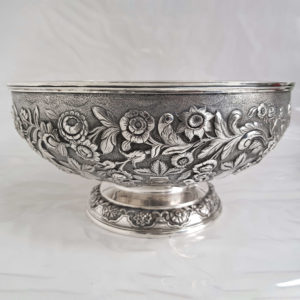
1827
David Crichton Rait
10222 George IV Antique Silver Bowl
£4,950
A magnificent Scottish antique silver centrepiece bowl with deep repousse decoration of flowers and foliage. The centre has the original bright gilding. Fantastic quality, large size and heavy gauge silver. To the front is an interesting presentation inscription. Weight 1567 grams, 30.3 troy oz. Diameter 26.2cm. Height 13.4cm. Glasgow 1827. Maker David Crichton Rait. Sterling silver. 19th century.
-

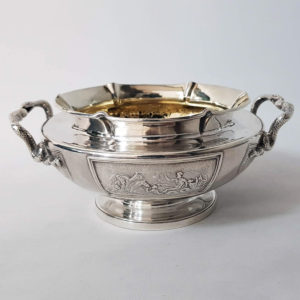
1834
William Barber
9979 Antique Silver Bowl
£750
A magnificent antique sterling silver cream bowl with a bright gilt interior; the two side handles formed as intertwined serpents. To the front and back there are classical scenes of the god Neptune with sea horses and mermen. Weight 526 grams, 16.9 troy ounces. Height 8.5cm. Rim diameter 13.4cm. Spread 19cm. London 1834. Maker William Barber. Sterling silver.